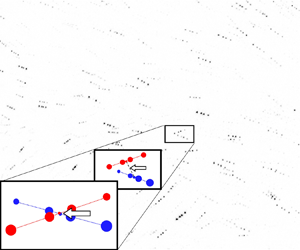Article contents
Particle radial distribution function and relative velocity measurement in turbulence at small particle-pair separations
Published online by Cambridge University Press: 30 June 2021
Abstract

Particle collisions in turbulent flow are critical to particle agglomeration and droplet coalescence. The collision kernel can be evaluated by radial distribution function (RDF) and radial relative velocity (RV) between particles at small separations  $r$. Previously, the smallest
$r$. Previously, the smallest  $r$ was limited to roughly the Kolmogorov length
$r$ was limited to roughly the Kolmogorov length  $\eta$ due to particle position uncertainty and image overlap. We report a new approach to measuring RDF and RV near contact (
$\eta$ due to particle position uncertainty and image overlap. We report a new approach to measuring RDF and RV near contact ( $r/a \approx 2.07$, where
$r/a \approx 2.07$, where  $a$ is particle radius). Three-dimensional particle tracking velocimetry using the four-pulse shake-the-box algorithm recorded short tracks with the interpolated midpoints registered as particle positions, avoiding image overlap and track mismatch. We measured RDF and RV of inertial particles in a one metre diameter isotropic air turbulence chamber with Taylor Reynolds number
$a$ is particle radius). Three-dimensional particle tracking velocimetry using the four-pulse shake-the-box algorithm recorded short tracks with the interpolated midpoints registered as particle positions, avoiding image overlap and track mismatch. We measured RDF and RV of inertial particles in a one metre diameter isotropic air turbulence chamber with Taylor Reynolds number  $Re_\lambda =324$,
$Re_\lambda =324$,  $a=12 - 16\ \mathrm {\mu }\textrm {m}$
$a=12 - 16\ \mathrm {\mu }\textrm {m}$  $({\approx }0.12\eta )$ and Stokes number
$({\approx }0.12\eta )$ and Stokes number  ${\approx }0.7$. At large
${\approx }0.7$. At large  $r$ the measured RV agrees with the literature, but when
$r$ the measured RV agrees with the literature, but when  $r<20\eta$ the first moment of negative RV starts to increase, reaching 10 times higher values than direct numerical simulations of non-interacting particles. Likewise, RDF scales as
$r<20\eta$ the first moment of negative RV starts to increase, reaching 10 times higher values than direct numerical simulations of non-interacting particles. Likewise, RDF scales as  $r^{-0.39}$ when
$r^{-0.39}$ when  $r>\eta$, reflecting the well-known scaling for polydisperse particles, but when
$r>\eta$, reflecting the well-known scaling for polydisperse particles, but when  $r\lessapprox \eta$, RDF scales as
$r\lessapprox \eta$, RDF scales as  $r^{-6}$, yielding 1000 times higher near-contact RDF than simulations. Such RV enhancement and extreme clustering at small
$r^{-6}$, yielding 1000 times higher near-contact RDF than simulations. Such RV enhancement and extreme clustering at small  $r$ can be attributed to particle–particle interactions including hydrodynamic interactions, which are not well-understood. Uncertainty analysis substantiates the observed trends. This first-ever simultaneous RDF and RV measurement at small separations provides a clear glimpse into the clustering and relative velocities of particles in turbulence near-contact.
$r$ can be attributed to particle–particle interactions including hydrodynamic interactions, which are not well-understood. Uncertainty analysis substantiates the observed trends. This first-ever simultaneous RDF and RV measurement at small separations provides a clear glimpse into the clustering and relative velocities of particles in turbulence near-contact.
Information
- Type
- JFM Papers
- Information
- Copyright
- © The Author(s), 2021. Published by Cambridge University Press
References
REFERENCES
A correction has been issued for this article:
- 13
- Cited by
Linked content
Please note a has been issued for this article.


